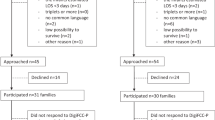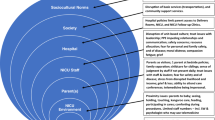Abstract
As the first extra-uterine setting for hospitalized infants, the neonatal intensive care unit (NICU) environment can make a lasting impact on their long-term neurodevelopment. This impact is likely mediated through both specific characteristics of the physical design of the care environment, as well as the experiences that occur within this environment. Recent studies document many established benefits of single-family rooms (SFRs). However, there is concern that infants who spend a prolonged time in SFRs without their parents being intimately involved in their care have reduced opportunities for meaningful experiences, with possible adverse consequences. The purpose of this report is to share an example of an application of the family-centered developmental care model through a hybrid NICU design, inclusive of both SFRs and semi-private bays. In this paper, we empirically describe the physical and operational considerations of a hybrid model, outline the strengths and challenges of this approach, and discuss implications for patients, families, and professionals.
This is a preview of subscription content, access via your institution
Access options
Subscribe to this journal
Receive 12 print issues and online access
$259.00 per year
only $21.58 per issue
Buy this article
- Purchase on Springer Link
- Instant access to full article PDF
Prices may be subject to local taxes which are calculated during checkout


Similar content being viewed by others
References
Morgan AS, Mendonça M, Thiele N, David AL. Management and outcomes of extreme preterm birth. BMJ. 2022;376:e055924.
Stoll BJ, Hansen NI, Bell EF, Walsh MC, Carlo WA, Shankaran S, et al. Trends in care practices, morbidity, and mortality of extremely preterm neonates, 1993–2012. JAMA. 2015;314:1039–51.
Norman M, Hallberg B, Abrahamsson T, Björklund LJ, Domellöf M, Farooqi A, et al. Association between year of birth and 1-year survival among extremely preterm infants in sweden during 2004–2007 and 2014–2016. JAMA. 2019;321:1188–99.
Rysavy MA, Li L, Bell EF, Das A, Hintz SR, Stoll BJ, et al. Between-hospital variation in treatment and outcomes in extremely preterm infants. N Engl J Med. 2015;372:1801–11.
Marlow N, Ni Y, Lancaster R, Suonpera E, Bernardi M, Fahy A, et al. No change in neurodevelopment at 11 years after extremely preterm birth. Arch Dis Child Fetal Neonatal Ed. 2021;106:418–24.
Cheong JL, Spittle AJ, Burnett AC, Anderson PJ, Doyle LW. Have outcomes following extremely preterm birth improved over time? Semin Fetal Neonatal Med. 2020;25:101114.
Cheong JLY, Olsen JE, Lee KJ, Spittle AJ, Opie GF, Clark M, et al. Temporal trends in neurodevelopmental outcomes to 2 years after extremely preterm birth. JAMA Pediatr. 2021;175:1035–42.
Volpe JJ. Brain injury in premature infants: a complex amalgam of destructive and developmental disturbances. Lancet Neurol. 2009;8:110–24.
Hüppi PS, Warfield S, Kikinis R, Barnes PD, Zientara GP, Jolesz FA, et al. Quantitative magnetic resonance imaging of brain development in premature and mature newborns. Ann Neurol. 1998;43:224–35.
Tierney AL, Nelson CA. Brain development and the role of experience in the early years. Zero Three. 2009;30:9–13.
Pineda RG, Neil J, Dierker D, Smyser CD, Wallendorf M, Kidokoro H, et al. Alterations in brain structure and neurodevelopmental outcome in preterm infants hospitalized in different neonatal intensive care unit environments. J Pediatr. 2014;164:52–60.e2.
Vohr B, McGowan E, McKinley L, Tucker R, Keszler L, Alksninis B. Differential effects of the single-family room neonatal intensive care unit on 18- to 24-month bayley scores of preterm infants. J Pediatr. 2017;185:42–8.e1.
Lester BM, Salisbury AL, Hawes K, Dansereau LM, Bigsby R, Laptook A, et al. 18-Month follow-up of infants cared for in a single-family room neonatal intensive care unit. J Pediatr. 2016;177:84–9.
Maitre NL, Key AP, Chorna OD, Slaughter JC, Matusz PJ, Wallace MT, et al. The dual nature of early-life experience on somatosensory processing in the human infant brain. Curr Biol. 2017;27:1048–54.
Smith GC, Gutovich J, Smyser C, Pineda R, Newnham C, Tjoeng TH, et al. Neonatal intensive care unit stress is associated with brain development in preterm infants. Ann Neurol. 2011;70:541–9.
Caskey M, Stephens B, Tucker R, Vohr B. Adult talk in the NICU with preterm infants and developmental outcomes. Pediatrics. 2014;133:e578–84.
Gonya J, Feldman K, Brown K, Stein M, Keim S, Boone K, et al. Human interaction in the NICU and its association with outcomes on the Brief Infant-Toddler Social and Emotional Assessment (BITSEA). Early Hum Dev. 2018;127:6–14.
Pineda R, Guth R, Herring A, Reynolds L, Oberle S, Smith J. Enhancing sensory experiences for very preterm infants in the NICU: an integrative review. J Perinatol. 2017;37:323–32.
Pineda R, Kellner P, Guth R, Gronemeyer A, Smith J. NICU sensory experiences associated with positive outcomes: an integrative review of evidence from 2015–2020. J Perinatol. 2023;43:837–48.
McAnulty G, Duffy FH, Butler S, Parad R, Ringer S, Zurakowski D, et al. Individualized developmental care for a large sample of very preterm infants: health, neurobehaviour and neurophysiology. Acta Paediatr. 2009;98:1920–6.
O’Callaghan N, Dee A, Philip RK. Evidence-based design for neonatal units: a systematic review. Matern Health Neonatol Perinatol. 2019;5:6.
van Veenendaal NR, van der Schoor SRD, Heideman WH, Rijnhart JJM, Heymans MW, Twisk JWR, et al. Family integrated care in single family rooms for preterm infants and late-onset sepsis: a retrospective study and mediation analysis. Pediatr Res. 2020;88:593–600.
Liu WF. Comparing sound measurements in the single-family room with open-unit design neonatal intensive care unit: the impact of equipment noise. J Perinatol. 2012;32:368–73.
Fay L, Real K, Haynes S, Daneshvar Z. Examining efficiency in open-bay and single-family room NICU designs. Adv Neonatal Care. 2023;23:355–64.
Dunn MS, MacMillan-York E, Robson K. Single family rooms for the NICU: pros, cons and the way forward. Newborn Infant Nurs Rev. 2016;16:218–21.
Lester BM, Hawes K, Abar B, Sullivan M, Miller R, Bigsby R, et al. Single-family room care and neurobehavioral and medical outcomes in preterm infants. Pediatrics. 2014;134:754–60.
Feeley N, Robins S, Genest C, Stremler R, Zelkowitz P, Charbonneau L. A comparative study of mothers of infants hospitalized in an open ward neonatal intensive care unit and a combined pod and single-family room design. BMC Pediatr. 2020;20:38.
Inder TE. Turns out not where but who you’re with that really matters. Pediatr Res. 2020;88:533–4.
Örtenstrand A, Westrup B, Broström EB, Sarman I, Åkerström S, Brune T, et al. The Stockholm Neonatal Family Centered Care Study: effects on length of stay and infant morbidity. Pediatrics. 2010;125:e278–85.
Lyngstad LT, Le Marechal F, Ekeberg BL, Hochnowski K, Hval M, Tandberg BS. Ten years of neonatal intensive care adaption to the infants’ needs: implementation of a family-centered care model with single-family rooms in Norway. Int J Environ Res Public Health. 2022;19:5917.
O’Brien K, Robson K, Bracht M, Cruz M, Lui K, Alvaro R, et al. Effectiveness of family integrated care in neonatal intensive care units on infant and parent outcomes: a multicentre, multinational, cluster-randomised controlled trial. Lancet Child Adolesc Health. 2018;2:245–54.
Weber A, Harrison TM, Steward D, Ludington-Hoe S. Paid family leave to enhance the health outcomes of preterm infants. Policy Polit Nurs Pr. 2018;19:11–28.
Pavlek LR, Mueller C, Jebbia MR, Kielt MJ, Nelin LD, Shepherd EG, et al. Perspectives on developing and sustaining a small baby program. Semin Perinatol. 2022;46:151548.
Erdei C, Inder TE, Dodrill P, Woodward LJ. The growth and development unit. A proposed approach for enhancing infant neurodevelopment and family-centered care in the neonatal intensive care unit. J Perinatol. 2019;39:1684–7.
Domanico R, Davis DK, Coleman F, Davis BO. Documenting the NICU design dilemma: comparative patient progress in open-ward and single family room units. J Perinatol. 2011;31:281–8.
Greene MM, Rossman B, Patra K, Kratovil A, Khan S, Meier PP. Maternal psychological distress and visitation to the neonatal intensive care unit. Acta Paediatr. 2015;104:e306–13.
Pineda R, Bender J, Hall B, Shabosky L, Annecca A, Smith J. Parent participation in the neonatal intensive care unit: predictors and relationships to neurobehavior and developmental outcomes. Early Hum Dev. 2018;117:32–8.
Treyvaud K, Spittle A, Anderson PJ, O’Brien K. A multilayered approach is needed in the NICU to support parents after the preterm birth of their infant. Early Hum Dev. 2019;139:104838.
Hall SL, Ryan DJ, Beatty J, Grubbs L. Recommendations for peer-to-peer support for NICU parents. J Perinatol. 2015;35:S9–13.
Brett J, Staniszewska S, Newburn M, Jones N, Taylor L. A systematic mapping review of effective interventions for communicating with, supporting and providing information to parents of preterm infants. BMJ Open. 2011;1:e000023.
Stevens DC, Helseth CC, Thompson PA, Pottala JV, Khan MA, Munson DP. A comprehensive comparison of open-bay and single-family-room neonatal intensive care units at Sanford Children’s Hospital. HERD. 2012;5:23–39.
Feeley N, Robins S, Charbonneau L, Genest C, Lavigne G, Lavoie-Tremblay M. NICU nurses’ stress and work environment in an open ward compared to a combined pod and single-family room design. Adv Neonatal Care. 2019;19:416–24.
Robson K, Smith J, Dunn MS. Towards an architecture of flexibility. J Perinatol. 2020;40:22–8.
White RD, Lehtonen L, Reber KM, Phillips R. A pivotal moment in the evolution of neonatal care. J Perinatol. 2023;43:538–9.
Acknowledgements
We thank our Brigham and Women’s Hospital NICU patients, families, and interdisciplinary colleagues for their contributions and support in preparing this report.
Author information
Authors and Affiliations
Contributions
TI conceptualized the design and model of care of the hybrid neonatal intensive care unit described here. CE and TI led the implementation of the Growth and Development Unit and pertinent programming described and conceptualized the elements presented in this descriptive report. GCC conducted an updated literature review and contributed to drafting the manuscript. CE drafted the initial manuscript, and reviewed and revised the manuscript. All authors approved the final manuscript as submitted and are accountable for all aspects of the work.
Corresponding author
Ethics declarations
Competing interests
The authors declare no competing interests.
Additional information
Publisher’s note Springer Nature remains neutral with regard to jurisdictional claims in published maps and institutional affiliations.
Rights and permissions
Springer Nature or its licensor (e.g. a society or other partner) holds exclusive rights to this article under a publishing agreement with the author(s) or other rightsholder(s); author self-archiving of the accepted manuscript version of this article is solely governed by the terms of such publishing agreement and applicable law.
About this article
Cite this article
Erdei, C., Corriveau, G.C. & Inder, T.E. A unit’s experience with hybrid NICU design: description of care model and implications for patients, families, and professionals. J Perinatol 43 (Suppl 1), 35–39 (2023). https://doi.org/10.1038/s41372-023-01815-0
Received:
Revised:
Accepted:
Published:
Issue Date:
DOI: https://doi.org/10.1038/s41372-023-01815-0



